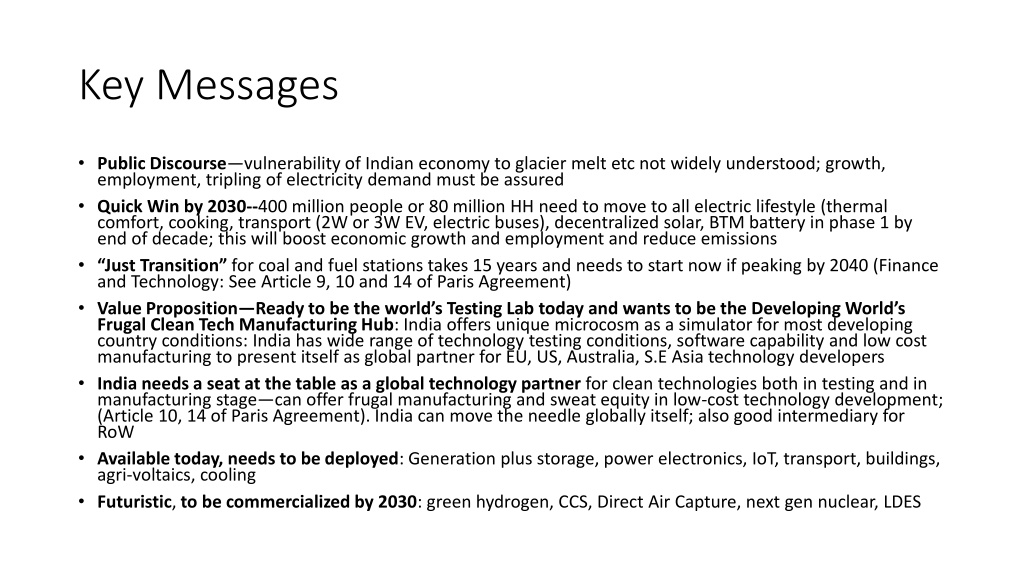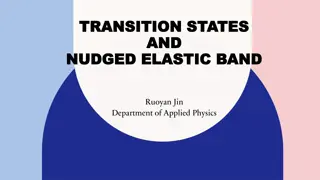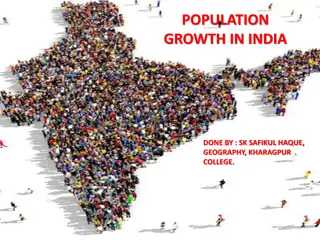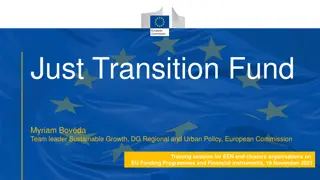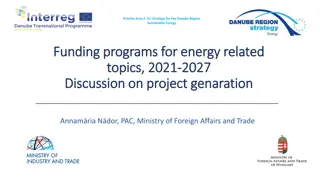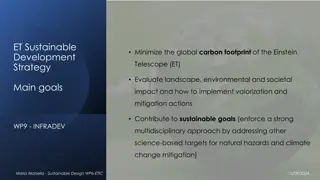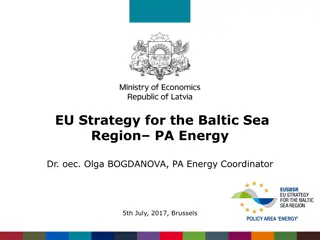India's Rapid Energy Transition Strategy for Sustainable Growth
India needs to shift to an all-electric lifestyle for millions of households by 2030 to boost economic growth, create employment, and reduce emissions. A just transition from coal is essential, with focus on technology testing and manufacturing for clean technologies. Public funding and partnerships are crucial for a successful energy transition.
Download Presentation

Please find below an Image/Link to download the presentation.
The content on the website is provided AS IS for your information and personal use only. It may not be sold, licensed, or shared on other websites without obtaining consent from the author. Download presentation by click this link. If you encounter any issues during the download, it is possible that the publisher has removed the file from their server.
E N D
Presentation Transcript
Key Messages Public Discourse vulnerability of Indian economy to glacier melt etc not widely understood; growth, employment, tripling of electricity demand must be assured Quick Win by 2030--400 million people or 80 million HH need to move to all electric lifestyle (thermal comfort, cooking, transport (2W or 3W EV, electric buses), decentralized solar, BTM battery in phase 1 by end of decade; this will boost economic growth and employment and reduce emissions Just Transition for coal and fuel stations takes 15 years and needs to start now if peaking by 2040 (Finance and Technology: See Article 9, 10 and 14 of Paris Agreement) Value Proposition Ready to be the world s Testing Lab today and wants to be the Developing World s Frugal Clean Tech Manufacturing Hub: India offers unique microcosm as a simulator for most developing country conditions: India has wide range of technology testing conditions, software capability and low cost manufacturing to present itself as global partner for EU, US, Australia, S.E Asia technology developers India needs a seat at the table as a global technology partner for clean technologies both in testing and in manufacturing stage can offer frugal manufacturing and sweat equity in low-cost technology development; (Article 10, 14 of Paris Agreement). India can move the needle globally itself; also good intermediary for RoW Available today, needs to be deployed: Generation plus storage, power electronics, IoT, transport, buildings, agri-voltaics, cooling Futuristic, to be commercialized by 2030: green hydrogen, CCS, Direct Air Capture, next gen nuclear, LDES
What would India need to do differently if public funding and partnership were assured? Rapid energy transition is not compatible with market based policies India must have mandate and command economy to make the pivot; invisible hand, carbon tax, market based subsidies not fast enough for 3-5 year industrial ramp up not spoiling market economy structure, rather just making a learning and cost reduction detour for 80 million HH after which market economy comes back; Can not treat rooftop solar, EVs, batteries, HVAC as consumer products; figure out cost of going fully electric for 80-90 million households and then secure funding Universal access to cheap and reliable clean energy in 21stcentury needs innovative low cost financing. Happens only when funding is assured from international partners De-risking strategy is not working. Cannot mobilize private capital in meaningful amounts; mainly mobilizing other public capital as co-finance; so need to change approach Large private corporates (Google, Microsoft) committed to running 24/7 on clean energy, meaning they have to procure clean firm energy, can assist India with innovation and R&D. This is the most likely source of private capital, otherwise mainly public funding will be needed
Value Proposition of Govt to Govt Partnerships TODAY BASE CASE WITH GoI OWN FUNDS (MEDIUM CASE) BY 2030 WITH FUNDING ONLY BY 2030 WITH FUNDING, TECH TRANSFER AND CAP. BLDG ELECTRICITY: RAMPING UP UTILITY SCALE RE GENERATION (450GW target) Grid Enhancement Technologies to improve utilization of existing T-lines while planning expansion; increase use of power electronics; increase RPOs Integrate GETs, Long duration energy storage, discom reforms and energy management software, full electrification of 80m HH with IoT etc TRANSPORT: Subsidies under FAME 2 for 2W+3W EVs, demo of E-buses; EV charging stations Expand EV market, target large share of 80m HHs; retire ICEs Fuel stations and gas cylinder distributors converted to battery swapping for 2W and 3W; EV charging in place AGRICULTURE: Solar Pumps Better implementation; water energy nexus; agrivoltaics pilots Diesel use almost negligible, LULUCF targets pursued through agrivoltaics and agro-forestry BUILDINGS: Very early stages of green standards definition, advocacy for sustainable housing, BUT implementation power in buildings sector not with central government, need to get into the weeds Better implementation of existing standards in Housing for All program; cooling action plan improvement and implementation; retrofit large stock of govt buildings for increased EE Massive upgrade of housing for all; focus on non-ownership affordable housing, full engagement of stakeholders, circular+carbon neutral buildings commonplace, no more 60 yr lock-in JUST TRANSITION: not yet started Consultation; housing; access to RE Coal miners, fuel stations, housing
Whom to Partner with, on what? EU/ European countries: JUST TRANSITION--green housing and redevelopment of brownfield areas into carbon neutral communities; HVAC technology for energy efficient heating and cooling; green hydrogen; RE integration on the distribution grid; grid management software; USA: long duration energy storage (LDES) and energy management software, power electronics ; other technologies funded by Advanced Research Projects Agency of Dept of Energy (ARPA-E) South East Asia (Thailand, Vietnam, Singapore, Japan): LOW CARBON COOLING technologies for tropical climates UK: COMMUNICATION/MESSAGING, awareness raising, policy and regulatory updates MDBs UNDER NEW CLIMATE ACTION PLANS: lowering India s share of capital costs for energy transition through concessional finance and sovereign-guaranteed low cost financing programs for full electrification of 80m HH; technical assistance; capacity building; M&E; working capital finance for manufacturing clean technology products domestically through Public Private Partnerships
